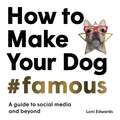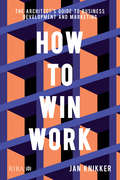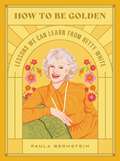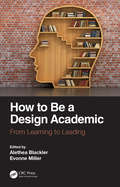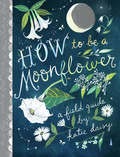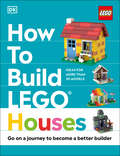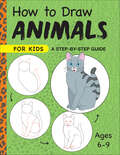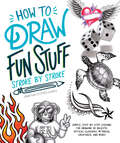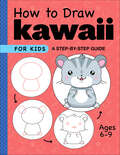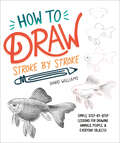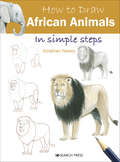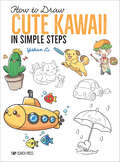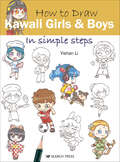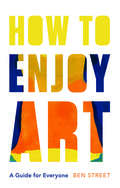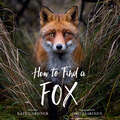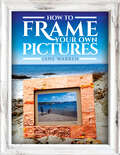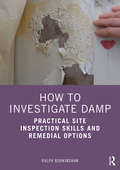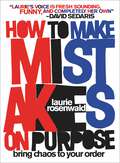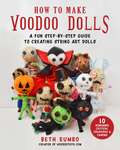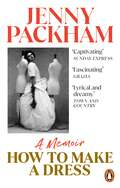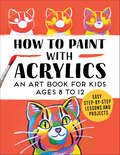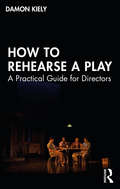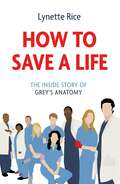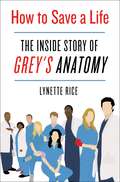- Table View
- List View
How To Make Your Dog #Famous: A Guide to Social Media and Beyond
by Loni EdwardsYou know your dog is the cutest but does everyone else know it too?In this book, Loni Edwards, the human behind the world's most influential pets, breaks down the path to fame. Discover insights into the success of social media's top pups and follow the essential steps on the road to fame - from crafting your brand to advocating for your pup on set. With expert guidance on how to be a good dog parent and make sure your pup is happy and healthy every step of the way, this is your one-stop guide to helping your dog win over hearts, one adorable post at a time.Featuring the stories of more than 40 of the most successful pet influencers:157 of Gemma, Amazing Graciedoodle, Barkley Sir Charles, Bertie Bert the Pom, Bronson the Bully, Brussels Sprout, Bully Baloo, Charlie the Black Shepherd, Chloe the Mini Frenchie (& Emma Bear), Coco the Maltese Dog (Coco & Cici), Cookie Malibu, Crusoe the Celebrity Dachshund, Daily Dougie, Dog named Stella, Ducky the Yorkie, Frame the Weim, Gone to the Snow Dogs, Harlow and Sage, Hi Wiley, Kelly Bove, Lilybug, Lizzie Bear, Louboutina the Hugging Dog, Maya Polar Bear, Mervin the Chihuahua, Milo and Noah, MJ the Beagle, Mr. Biggie, Popeye the Foodie, Puggy Smalls, Reagandoodle, Remix the Dog, Rocco Roni, Super Corgi Jojo, Super Scooty, Tatum, That Goldendoodle, The Bike Dog, Tika the Iggy, Tuna Melts my Heart, Tupey the Borzoi, Verpinscht, Winnie the Cocker, Wolfgang 2242
How To Make Your Dog #Famous: A Guide to Social Media and Beyond
by Loni EdwardsYou know your dog is the cutest but does everyone else know it too?In this book, Loni Edwards, the human behind the world's most influential pets, breaks down the path to fame. Discover insights into the success of social media's top pups and follow the essential steps on the road to fame - from crafting your brand to advocating for your pup on set. With expert guidance on how to be a good dog parent and make sure your pup is happy and healthy every step of the way, this is your one-stop guide to helping your dog win over hearts, one adorable post at a time.Featuring the stories of more than 40 of the most successful pet influencers:157 of Gemma, Amazing Graciedoodle, Barkley Sir Charles, Bertie Bert the Pom, Bronson the Bully, Brussels Sprout, Bully Baloo, Charlie the Black Shepherd, Chloe the Mini Frenchie (& Emma Bear), Coco the Maltese Dog (Coco & Cici), Cookie Malibu, Crusoe the Celebrity Dachshund, Daily Dougie, Dog named Stella, Ducky the Yorkie, Frame the Weim, Gone to the Snow Dogs, Harlow and Sage, Hi Wiley, Kelly Bove, Lilybug, Lizzie Bear, Louboutina the Hugging Dog, Maya Polar Bear, Mervin the Chihuahua, Milo and Noah, MJ the Beagle, Mr. Biggie, Popeye the Foodie, Puggy Smalls, Reagandoodle, Remix the Dog, Rocco Roni, Super Corgi Jojo, Super Scooty, Tatum, That Goldendoodle, The Bike Dog, Tika the Iggy, Tuna Melts my Heart, Tupey the Borzoi, Verpinscht, Winnie the Cocker, Wolfgang 2242
How To Win Work: The architect's guide to business development and marketing
by Jan KnikkerYou are a great designer, but no-one knows. Now what? This indispensable book, written by one of the most influential marketers in architecture, will demystify Public Relations and marketing for all architects, whether in large practices or practicing as sole practitioners. It bridges the distance between architects and marketing by giving practical tips, best practice and anecdotes from an author with 20 years’ experience in architecture marketing. It explains all aspects of PR and Business Development for architects: for example, how to write a good press release; how to make a fee proposal; how to prepare for a pitch. It gives examples of how others do it well, and the pitfalls to avoid. In addition, it discusses more general aspects which are linked to PR and BD, such as being a good employer, ethics for architects and the challenges when working abroad. Featuring vital insights from a wide variety of architects, from multinational practices to small offices, this book is an essential companion to any architectural office.
How to Be Golden: Lessons We Can Learn from Betty White
by Paula BernsteinIf there's one thing the nation can agree on--we all love Betty White! This spirited homage to Betty captures her unique humor, timeless wisdom, and impish irreverence that's made her one of America's longest lasting and most beloved stars. An unparalleled American icon, Betty White started show business in 1939 in radio and was a pioneer in the early days of TV. Over eight decades, she's appeared on countless sitcoms, game shows, and talk shows, including the iconic comedy hits The Mary Tyler Moore Show and The Golden Girls. Her accolades over the years include two Emmy nominations, a Grammy, and induction into the Television Academy Hall of Fame, while she had her best decade yet as a nonagenarian: becoming the oldest person to host SNL, starring in a Super Bowl ad, and winning praise with her popular supporting role in Hot in Cleveland. Through it all, her "don't take yourself too seriously" attitude appeals to legions of fans, spanning all generations.How to Be Golden recounts her engaging life story while weaving in her words of wisdom and insight about love, friendship, work, family, sex, acting, aging, beauty, and more.
How to Be a Design Academic: From Learning to Leading
by Alethea Blackler and Evonne MillerThis book is about how to be a design academic. In another words, how to manage the various challenges, requirements, and processes that come with both the everyday and extra-ordinary parts of an academic role in design fields (from architecture, urban design, interior design and landscape architecture, to fashion, industrial, interaction and graphic design). The book is organised in two parts – Part 1, Starting out and Part 2, Becoming a Leader. It includes real-life experiences of actual academics and offers a wide range of experiences of authors from early career researchers to full professors and heads of schools. It contains all aspects of academic life, including the highs and lows of teaching, research, leadership, and managing your working life and your career. This book is perfect for academics, aspiring academics, and research students in a wide range of design fields.
How to Be a Moonflower
by Katie DaisyHow to Be a Moonflower, the new book from bestselling author Katie Daisy, celebrates the magic and mystery of the world at night.Discover the world that awakens after everyone else has gone to sleep. In this lavishly illustrated book, New York Times–bestselling artist Katie Daisy explores the mystery and magic of the nighttime. Join her on a journey from dawn to dusk, complete with quotes, poems, meditations, field guides to different nocturnal flora and fauna, and charts that map out the cosmos. From night-blooming flowers to cozy campfires, from moon baths to meteor showers, Katie Daisy's lush illustrations capture the beauty that comes to life in the darkness.BELOVED AUTHOR: Known for her lush, painterly artwork and love of the natural world, NEW YORK TIMES–bestselling author Katie Daisy has 112K followers on Instagram, where you will find frequent posts featuring her vibrant illustrations.A CELEBRATION OF NATURE: Nature-lovers and plant-appreciators will find much to admire in this book. Illustrating everything from the phases of the moon to fluttering moths, Katie Daisy has a knack for capturing the very best this magical world has to offer.EXPLORE THE WONDERS OF NIGHT TIME: The nighttime offers time for reflection, exploration, and adventure. This book will help you make the most of those mystical, after-dark hours and observe the hidden wonders that come to life at nightDELUXE PACKAGE: Featuring a tactile two-piece case with silver metallic ink on the spine and back cover, How to Be a Moonflower makes a beautiful gift for the people in your life who look to art and illustration for creative encouragement, self-exploration, and mindfulness.Perfect for:• Fans of Katie Daisy's artwork and previous book HOW TO BE A WILDFLOWER• free spirits• art and nature lovers• tarot readers and moon worshippers
How to Build LEGO Houses: Go on a Journey to Become a Better Builder
by Hannah Dolan Nate Dias Jessica FarrellDiscover how to build your dream LEGO houses – with tips and techniques from expert LEGO builders. Create 30 incredible LEGO homes. Build a beautiful thatched cottage, make a cool treehouse, create a fantasy home with a slide, spook your friends with a haunted house, and much more. From foundations and roofs to balconies and microscale buildings, learn everything you need to create your own LEGO houses. You can build anything! ©2021 The LEGO Group
How to Draw Animals for Kids: A Step by Step Guide (Drawing for Kids Ages 6 to 9)
by Rockridge PressLearn to draw animals with step-by-step activities for kids ages 6 to 9Anyone can be an artist—all you need is your imagination! Learn how to draw beginner-friendly adorable animals with this step-by-step drawing book for kids. It's full of activities, helpful tips, and lots of animals to draw—from cats and dogs to owls and elephants. A great resource for parents and teachers to teach kids to draw shapes, lines, and other drawing basics. Build on these skills, advance to more challenging animals, and then customize them into something unique. Just grab a pencil and get ready to explore the animal kingdom!A world of animals—Draw animals from the land, sea, and sky, including dolphins, bald eagles, sloths, pandas, goldfish, penguins, and more.Step-by-step method—Follow along and develop your drawing from basic shapes like circles and lines all the way to a beautifully detailed animal.Time to get creative—Get your imagination going with blank scenes that let you draw in your own animals, along with extra drawing ideas so you can keep creating.Discover how to draw animals the easy way with the step-by-step instructions in this book about drawing for kids.
How to Draw Fun Stuff Stroke-by-Stroke: Simple, Step-by-Step Lessons for Drawing 3D Objects, Optical Illusions, Mythical
by Jonathan Stephen HarrisA fresh and exciting drawing guide for young artists who seek projects that are out of the ordinary.Are you tired of drawing the same boring stuff? Artist and author Jonathan Stephen Harris shows you how to draw almost anything with 40 fun and exciting projects that are anything but boring. You'll learn how to create crazy trick art, amazing 3D objects, mind-blowing anamorphic illustrations, and brain-twisting optical illusions. Every project features detailed, step-by-step instructions and illustrations that use color to help teach you exactly how to do it. You'll start by learning the basics of drawing, what tools you need, and the basic techniques you need to know so you can create your own amazing drawings. Soon you'll be creating works of amazing art that is out of this world! Here's what's inside:40 exciting drawing projects that will thrill young artists of all levels of ability.Detailed, step-by-step instructions that take readers through every drawing from start to finish, using color to illustrate new lines so the reader can clearly see the next steps.Simple tutorials for basic drawing skills like shading as well as creating textures and surfaces so readers can learn drawing the right way.Tons of creative ideas that will inspire you to create your own amazing works of art.
How to Draw Kawaii for Kids: A Step-by-Step Guide (Drawing for Kids Ages 6 to 9)
by Rockridge PressLearn to draw kawaii with step-by-step activities for kids ages 6 to 9Anyone can be an artist—all you need is your imagination! Learn how to draw kawaii with this step-by-step drawing book. It's full of activities, helpful tips, and lots of different things to draw, like food, animals, people, and other objects.Start by learning about shapes, lines, and other drawing basics, then find out how to construct a complete drawing in just a few simple steps. As you build your skills, try out more challenging things to draw and customize each drawing to make it your own. Just grab a pencil and get ready to explore the wonderful world of kawaii!An adorable medley—Find all kinds of super cute things to draw, including a delightful donut, a pretty panda, a prickly cactus, a brave superhero, and many more.Step-by-step method—Follow along and develop your drawing from basic shapes like circles and lines all the way to a beautifully detailed drawing.Time to get creative—Get your imagination going with blank scenes that let you explore your creativity, along with extra ideas so you can keep drawing.Discover the art of drawing kawaii with this book about how to draw for kids.
How to Draw Stroke-by-Stroke: Simple, Step-by-Step Lessons for Drawing Animals, People, and Everyday Objects (Idiot's Guides)
by David WilliamsLearn to draw and have fun doing it! Even if you&’re only starting out this book will show you how to draw in no timeThis book teaches readers simple stroke-by-stroke techniques to learn how to draw people, animals, the natural world, and everyday objects. Even if you&’ve never picked up a pen to draw before, this book will guide you in creating pictures you&’ll want to display.This step-by-step drawing book for beginners is an easy way to learn to draw or improve your drawing skills. It includes: • Over 40 drawing projects for a variety of subjects, from people and nature to animals • Simple, step-by-step instructions that show you how to create each drawing from start to finish • Helpful tips for setting up your personal drawing space and purchasing the right supplies • Clear explanations of techniques, concepts, and important terminology that every new artist should know How to Draw Stroke by Stroke is a wonderful start for any beginner artist! It takes readers through the fundamentals of drawing such as tools for drawing, techniques and key terms, and how to set up your drawing environment. Then they&’re introduced to 44 drawings that range from simple to advanced such as drawing a natural face, butterflies and flowers, the night sky, and more. Each drawing utilizes color to show you when new strokes are added which makes this book easy to follow and the art of drawing fun to learn. Both children and adults will love working through this book and creating drawing projects and doodles that they&’re proud of!
How to Draw: African Animals
by Jonathan NeweyCapture the splendour of the African savannah by drawing this collection of stunning animals and birds. Watch them come to life in six easy steps. Award-winning artist Jonathan Newey teaches you to transform simple shapes into the iconic Big Five (lion, leopard, rhinoceros, elephant and buffalo), as well as towering giraffes, distinctive zebras and striking flamingos. There are 26 different animals to create, in a variety of poses and styles. Each project starts with a few basic outlines and progresses into a finished tonal drawing, and a final coloured version shows you how to develop your drawing even further. Perfect for beginners, as well as budding artists, you’ll be amazed how easily you too can draw African animals with this inspiring guide.
How to Draw: Cute Kawaii
by Yishan LiKawaii is a Japanese word meaning ‘super-cute’, and it’s a trend that’s sweeping the globe. Anything can be drawn in the kawaii style, from animals, people, vegetables and flowers to food, vehicles and household items. Expert comic book and manga artist Yishan Li shows you how to achieve amazingly cute characters in a few simple steps. Do you want to draw a singing cactus, a cheeky camera, a crying onion, or a playful panda? The choice is yours! How to Draw: Cute Kawaii uses material from the best-selling How to Draw series, plus 32 brand new projects! There are over 100 projects to choose from, each full of character and charm. Each one is developed in eight easy stages from a rough sketch of the basic shapes through to the finished, coloured drawing, making this book appealing to adults and children of all ages and abilities.
How to Draw: Kawaii Girls and Boys
by Yishan LiKawaii is a Japanese word meaning ‘super-cute’, and it’s a trend that’s sweeping the globe. Anything can be drawn in the kawaii style, from animals, people, vegetables and flowers to food, vehicles and household items. Here, expert comic book and manga artist Yishan Li shows you how to achieve amazingly adorable girls and boys from all walks of life in just a few simple steps - from waiters and doctors to princesses and fairies. There are 28 different drawings to choose from, all full of personality and bubbling over with charm. Each one is developed in 8 easy stages from a rough sketch of the basic shapes through to the finished, coloured drawing, making this book suitable for adults and children of all ages and abilities.
How to Enjoy Art: A Guide for Everyone
by Ben StreetAn entertaining and lively guide to rediscovering the pleasure in artHow to Enjoy Art: A Guide for Everyone provides the tools to understand and enjoy works of art. Debunking the pervasive idea that specialist knowledge is required to understand and appreciate art, instead How to Enjoy Art focuses on experience and pleasure, demonstrating how anyone can find value and enjoyment in art. Examples from around the world and throughout art history—from works by Fra Angelico and Berthe Morisot to Kazuo Shiraga and Kara Walker—are used to demonstrate how a handful of core strategies and skills can help enhance the experience of viewing art works. With these skills, anyone can encounter any work of art—regardless of media, artist or period—and find some resonance with their own experiences. How to Enjoy Art encourages us to rediscover the fundamental pleasure in viewing art.
How to Find a Fox
by Kate Gardner**Winner of the Mockingbird Award**Look for tracks. Listen for yips. Be as still as a pebble. Taking kids on an imaginary trek through different landscapes and seasons, How to Find a Fox celebrates one of our planet's most graceful and enchanting creatures: the red fox. Ossi Saarinen's stunning wildlife photos and Kate Gardner's lively and informative words capture the magical and profound connection between animals and humans. Readers will be inspired to get outside and make their own discoveries--maybe with a camera in-hand, just like Ossi.
How to Frame Your Own Pictures (Crafts Ser.)
by Jane WarrenThis visually appealing book introduces readers with no previous knowledge of the craft to simple techniques for creative home picture-framing. It shows how investing in a few essential hand tools and basic materials can save you hundreds of pounds on your framing costs, and help you create high-quality handmade gifts for family and friends. Step-by-step photos and easy-to-follow instructions - as well as useful ‘insider tips’ - reveal the secrets of DIY framing. Ten original projects include simple techniques to frame canvases and stretch canvas artworks, make standard frames and box frames using readily available timber, and even craft a 60-minute mirror frame from a plank of wood. You’ll learn techniques for cutting mount-board and glass, and discover the secrets of easy gilding, decoupage and copper embossing to decorate your frames. The Woodland Pie framing style is all about accessible creativity; making easy and appealing frames from basic materials and always using hand-painted or hand-made finishes. Find out how to create a lustrous, versatile, go-to paint effect for your picture frames using nothing other than household emulsion paint, water, and wire wool! This brilliant how-to book cuts out the unnecessary and promises to get you hobby framing in no time – with creative flair.
How to Investigate Damp: Practical Site Inspection Skills and Remedial Options
by Ralph BurkinshawThe aim of this book is to take the reader by the hand and show them exactly how to carry out various inspection techniques to identify the causes of damp in buildings. This is achieved by taking them through a variety of investigation methods using real-life case studies illustrated by dozens of sketches, drawings and photographs – and considerable insight into how investigations can be conducted on site – and also including most importantly the Client’s input and perspective on a damp issue. Written in non-technical language by a leading expert and author on damp, the book begins by outlining the common types and phases of an investigation, the equipment required and the nature of potential remedial work. Case studies then cover condensation, penetrating damp, plumbing and roof leaks, below ground moisture and flooding – and less common causes such as residual construction moisture. The final section contains step by step guidance on procedures such as using a humidity box, inspecting a cavity wall, using a damp meter and extracting and testing a plaster sample for salt content. The book is full of hints and tips developed over a career spent investigating, diagnosing and remediating damp issues and is essential reading for surveyors looking to improve their skills and knowledge of this often complex defect. The book will also be very useful for homeowners trying to self-diagnose, and architects, engineers and other professionals who need to gain insight into common problems caused by moisture imbalance in buildings.
How to Make Mistakes On Purpose: Bring Chaos to Your Order
by Laurie RosenwaldBased on Laurie Rosenwald's popular workshop, How to Make Mistakes On Purpose reveals an intuitive, entertaining way to come up with truly original ideas. Three generations of humans have now been molded into results-oriented workers who cannot mess up, and therefore may never innovate either. Shared software, skills, and experiences equal no surprises. Surrounded by the unwavering, reliable results made possible by a machine, we all marinate in this ubiquitous cybersauce. Behold! Thousands of shiny new apps, sites, products, and services that look, feel, and are essentially the same. Because computers don&’t make mistakes.Chance is the natural foil to the digital. We combine both for originality. This makes for the kind of exciting, hopeful future we want. We embrace technology but need to slap it around a bit to get someplace new.Human error sparks connections. In a relaxed situation where one&’s hypercritical demons are AWOL, the snap, crackle, pop of brainstorms happen all around us.A fresh, colorful guide to discovery, with clearly marked directions and witty prompts, this is a book about living a productive, individualistic life. Whatever your job, it gives you a way to zig while everyone around you can only zag. It will also make you laugh along the way.
How to Make Voodoo Dolls: A Fun Step-by-Step Guide to Creating String Art Dolls
by Dr. Beth RumboA fantastically fun handbook for making DIY voodoo dolls: craft with yarn, embroidery floss, pipe cleaners, fabric paint, and more! This unofficial guide to creating fun voodoo string dolls is the first of its kind in offering step-by-step directions for making these fun and funky charms. Great for kids and adults, these easy-to-make dolls will entertain you for hours with their quirky looks and personalities. How to Make Voodoo Dolls has tons of photographs to lead you through the process of creating these cute, kooky characters, but will also prime your imagination as you start on the way to making your own creations. Learn how to make your favorite ghoulish creatures such as: SkeletonFrankensteinWerewolfDraculaAnd more! Just be careful sticking those pins as a final touch!
How to Make a Dress: Adventures in the art of style
by Jenny Packham‘From inspiration to sketch, pattern to fabric, the making of a dress has been the structure that has held me, and my passion to dress others is the momentum of my life.’ Jenny Packham is one of Britain’s leading designers and most in-demand couturiers, known for her exquisite dresses made for brides, celebrities and even royalty. In How to Make a Dress, she explores her creative journey in a brilliant meditation on life and style.Beginning with the search for creative inspiration and taking us into her studio then onto the red carpet and beyond, she asks the questions that have preoccupied us for centuries: What makes the perfect dress? What do our clothes mean to us? And why do we dress the way we do? Whether she is on the trail of Marilyn Monroe in LA, designing a bespoke piece for the red carpet or sketching for a new collection, Jenny documents her pursuit of the eternal truths of style. Decades in the making, How to Make a Dress is an unforgettable book for anyone who has ever loved a piece of clothing.
How to Paint with Acrylics: An Art Book for Kids Ages 8 to 12
by Rockridge PressUnleash kids' creativity with easy acrylic tutorials and projects for ages 8 to 12 Painting is so much fun! Whether the child in your life wants to become a great painter someday or just express themselves artistically, this book will show them how to use acrylic paints to create artwork of their own. They'll find step-by-step lessons and projects that teach them everything from setting up their art station to painting light and texture like a pro.This standout among art books for kids age 8-12 includes:Acrylic painting 101—Kids will learn about the tools an artist uses, then dive into beginner-friendly lessons about colors, lines and shapes, positive and negative space, and more.Skill-building projects—Inspire kids to boost their acrylic skills with painting projects that start out simple and become more challenging.Tips and inspiration—This art book for kids helps them master basic painting techniques with pro tips and creative prompts that encourage them to express themselves in new ways.Introduce kids to the joy of painting with How to Paint with Acrylics.
How to Rehearse a Play: A Practical Guide for Directors
by Damon KielyBased on interviews with over forty award-winning artists, How to Rehearse a Play offers multiple solutions to the challenges that directors face from first rehearsal to opening night. The book provides a wealth of information on how to run a rehearsal room, suggesting different paths and encouraging directors to shape their own process. It is divided into four sections: lessons from the past: a brief survey of influential directors, including Stanislavski’s acting methods and Anne Bogart’s theories on movement; a survey of current practices: practical advice on launching a process, analyzing scripts, crafting staging, detailing scene work, collaborating in technical rehearsals and previews, and opening the play to the public; rehearsing without a script: suggestions, advice, and exercises for devising plays through collaborative company creation; rehearsal workbook: prompts and exercises to help directors discover their own process. How to Rehearse a Play is the perfect guide for any artist leading their first rehearsal, heading to graduate school for intense study, or just looking for ways to refresh and reinvigorate their artistry.
How to Save a Life: The Inside Story of Grey's Anatomy
by Lynette RiceThe first inside story of one of TV's most popular and beloved dramas, Grey's Anatomy.' <P><P>More than 15 years after its premiere, Grey's Anatomy remains one of the most beloved dramas on television in the US and the UK. It continues to win its time slot and has ranked in the Top 20 most watched shows in primetime for most of its 17-season run. It currently averages more than 9 million viewers each week. Now it's time to hear from the people who made the show happen. <P><P>A cultural touchstone, it introduced the unique voice and vision of Shonda Rhimes, it made Ellen Pompeo, Sandra Oh and T.R. Knight household names, and injected words and phrases into the cultural lexicon like 'McDreamy,' and 'you're my person.' And the behind-the-scenes drama has always been just as juicy as what was happening in front of the camera, from the high-profile firing of Isaiah Washington to Katherine Heigl's fall from grace and Patrick Dempsey's shocking death episode. The show continued to haemorrhage key players, but the beloved hospital series never skipped a beat. Lynette Rice's How to Save A Life takes a deep dive into the show's humble start, while offering exclusive intel on the behind-the-scenes culture, the most heartbreaking departures and the more polarizing plotlines. It's the perfect gift for all Grey's Anatomy stans out there. <P><P><b>A New York Times Best Seller</b>
How to Save a Life: The Inside Story of Grey's Anatomy
by Lynette RiceTHE NEW YORK TIMES BESTSELLERThe first inside story of one of TV's most popular and beloved dramas, Grey's Anatomy.More than fifteen years after its premiere, Grey’s Anatomy remains one of the most beloved dramas on television and ABC's most important property. It typically wins its time slot and has ranked in the Top 20 most-watched shows in primetime for most of its seventeen-season run. It currently averages more than eight million viewers each week.Beyond that, it’s been a cultural touchstone. It introduced the unique voice and vision of Shonda Rhimes; it made Ellen Pompeo, Sandra Oh and T.R. Knight household names; and injected words and phrases into the cultural lexicon, such as “McDreamy,” "seriously," and “you’re my person.” And the behind-the-scenes drama has always been just as juicy as what was happening in front of the camera, from the controversial departure of Isaiah Washington to Katherine Heigl’s fall from grace and Patrick Dempsey's shocking death episode. The show continued to hemorrhage key players, but the beloved hospital series never skipped a beat.Lynette Rice's How to Save A Life takes a totally unauthorized deep dive into the show’s humble start, while offering exclusive intel on the behind-the-scenes culture, the most heartbreaking departures and the more polarizing plotlines. This exhaustively enthusiastic book is one that no Grey’s Anatomy fan should be without.
